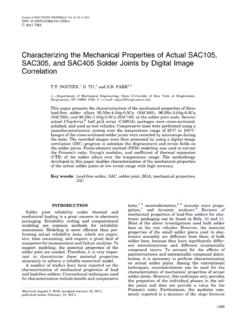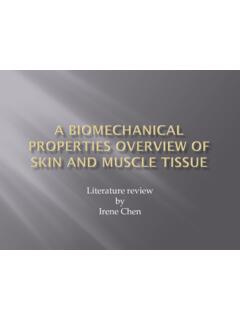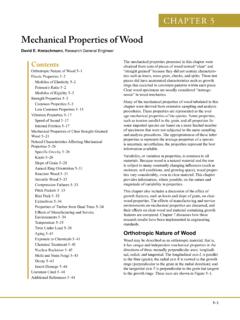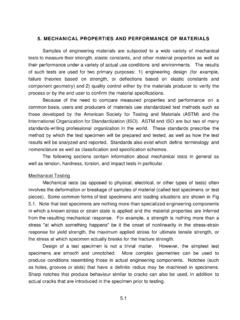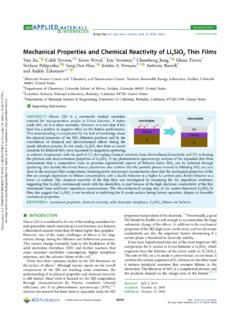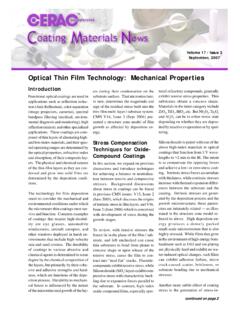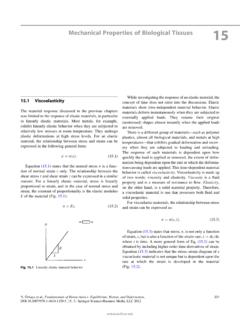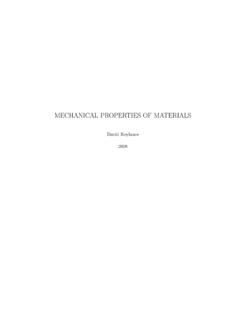Transcription of Mechanical properties and Young's modulus of human skin …
1 Arch Dermatol Res 269, 221-232 (1980) Archives of Deermatological searcn 9 Springer-Verlag 1980 Original Contributions Mechanical properties and Young's modulus of human Skin in Vivo P. G. Agache 1, C. Monneur 1, J. L. Leveque 2, and J. De Rigal z 1 Clinique Dermatologique Universitaire, H6pital R6gional, F-25030 Besanqon Cedex, France 2 Groupe de Physique, Laboratoire de Recherche de l'Or6al, 1 avenue de Saint Germain, F-93600 Aulnay-Sous-Bois, France Summary. The Mechanical properties of the in vivo dermis were measured by means of a torque applied to the skin.
2 The resulting deformation of 2-6 ~ including the immediate and delayed visco-elastic components, as well as the relaxation were measured, and the raw values corrected for a constant skin thickness. The experiment performed on 138 individuals from 3 to 89 years old revealed a diminished elasticity and stretchability after the age of 30, associated with an increase in the visco-elastic component. The Young's modulus doubles with age. The results are discussed in terms of the various models proposed to explain dermal structure.
3 Key words: Skin biomechanics - Ageing - Collagen - Dermis - Young's modulus Zusammenfassung. Die mechanischen Eigenschaften der Haut in vivo wurden anhand eines Drehmoments gemssen. Die so erhaltene Deformierung (2 und 6~ ihre sofortige und ihre viskoelastische verz6gerte Komponente, sowie ihre Erschlaffung wurden gemessen und ffir eine konstante Hautdicke korrigiert. Der Versuch betraf 138 Personen im Alter von 3 bis 89 Jahren und zeigt eine Verminderung der Elastizitfit und der Dehnbarkeit mit Erh6hung der viskoela- stischen Komponente nach 30 Jahren.)
4 Das Youngsche Modul verdoppelt sich mit zunehmendem Alter. Die Ergebnisse werden in bezug auf die verschiedenen Hautstruktur Modelle diskutiert. Sehliissdwiirter: Biomechanik der Haut - Altern - Kollagen - Haut - Youngsches Modul. The biomechanical properties of the dermis were studied in vivo by means of a torque. The torque, maintained at a constant strenght, was applied through the Offprint requests to: P. G. Agache (address see above) 0340-3696/80/0269/0221/$ 222 Agache et al. intermediary of a disc fixed on the skin's surface.
5 The torque rotated the disc to an angle 0 measuring the distension of the skin. The simultaneous measurement of the skin fold thickness allowed the calculation of this angle in terms of a constant thickness. Thus, it was possible to establish for a given force, a point on the stress- strain curve. In an earlier work [10], we calculated a point on this curve situated on the lower portion of the linear zone. The present work proposes to define another point on this linear zone for a larger stress, and to deduce the slope of the graph.
6 The chosen stress was 9 10-3N 9 m, inducing a twist 0 of 2-6 ~ varying among the individuals. This strain falls within the limits of the demands made on the skin by usual stress. The 2 min manipulation is completely painless. As we shall see, this work also allows a definition of additional biomechanical parameters, and an hypothesis for the genesis of tissue modification. Material and Methods The apparatus and protocol used were described in our previous publication [10]. The only difference lies in the greater intensity of the applied force ( 9 10 3 N 9 m).
7 The 138 individuals examined had no dermatological anomaly at the test site. Table 1 of the previous publication [10] shows the age and sex distribution. The displacement curve, plotted as a function of time, maintains the same form as that for lesser strains (Fig. 2 in [10]). The parameters used were immediate distension (Ue), final distension after 2 min (Uf), delayed distension (Uv) calculated as Uf-Ue and immediate retraction (Ur). Late retraction, total retraction, and residual strain were not taken into consideration because they correspond to weak skin strains that might be overly influenced by the rubbing forces of the testing apparatus.
8 Immediately after the application of the twist the skin fold thickness was measured at the same site. The statistical results of the measurement are shown in Fig. 4 of our previous paper [10]. Each individual measurement of the skin fold was used to calculate the biomechanical parameter values for a given individual for a thickness of I mm. These normalised parameters are marked with an asterisk (Ue*, Uv*, ). The mathematical calculation of the skin's strain due to the twist is shown in the appendix, as well as that of the young modulus .
9 The Student-Fischer t-test was used for statistical analysis tO compare the means, with a corrected formula for a sample of less than 30. Results Absolute Parameters The modification of the raw and normalised parameters for a constant skin thickness are presented in Figs. 1 --4. All the curves are characterised by a sudden decrease at about the age Of 30. Seven out of eight parameters show a statistically significant difference (Table 1) both in men and in women, yet no significant difference was noted between the sexes. Relative Parameters Calculations were made for each age group concerning two relative parameters: Uv/Ue and Ur/Ue (Figs.)
10 5 a and 6). These two parameters are of value: firstly, they are independent of skin thickness and, secondly, Ur represents the skin's aptitude to return to its initial state after having withstood a 2 rain strain. Young's modulus of human Skin in Vivo 223 3(X ~(~) Men I _ --BB-- -Women 200 XIO- , Ue(mV) 30r 200, 100 Age a b Fig. 1. a Ue and b Ue* as a function of age. Ordinates in mV. Mean and standard error of the mean The visco-elastic proportion of the total distension (Uv/Ue) rose progressively with age (Fig. 5 a). No significant difference was noted between the sexes, only a greater variation of the values according to age was found in the men.
